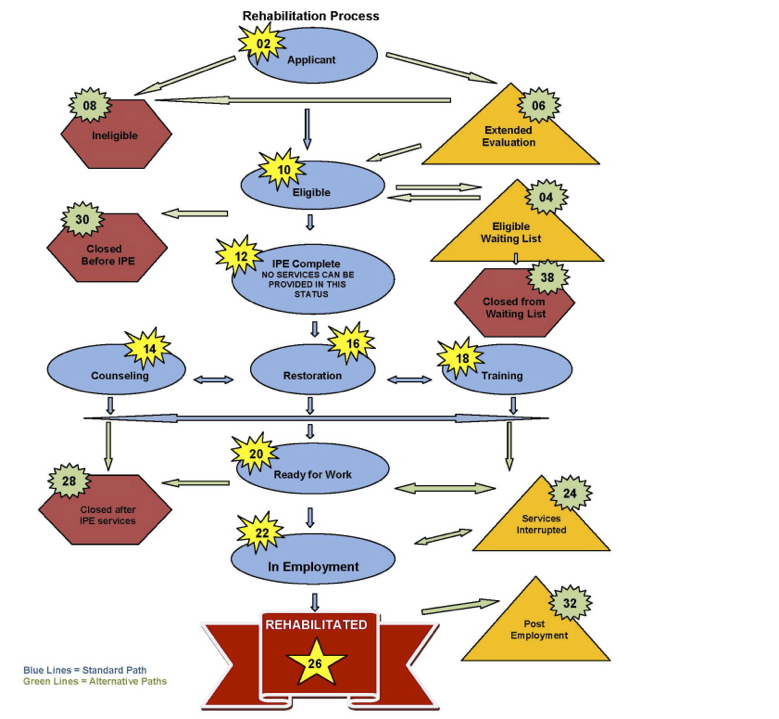The VR Process
Vocational Rehabilitation: History, System & Process
An infusion module for Interpreter Education Programs
This section provides information about the Vocational Rehabilitation process.
The Rehabilitation Process Presentation
Download Word Version of Presentation | Download PDF Version of Presentation
This presentation was developed as part of the instructional materials for Module 1: VR as a System, which is part of an online professional development series for VR interpreters hosted for the NCIEC by the University of Northern Colorado MARIE Center and is used here with permission. You may note reference to “insight”. This term is used within the UNC and refers to a term used in their courses. It should be disregarded.
Any client who works with Vocational Rehabilitation services encounters a specific process that helps to determine the needs of the client and what supports should be put in place to provide for a positive vocational outcome. While the process may vary slightly from state to state, the general overall process is very similar.
This section focuses in on understanding this process so that interpreters can understand the big picture of how VR services work and how the specific step being interpreted fits into the larger picture.
This narrated PowerPoint presentation on the VR Process is 15 minutes in length.
To view the presentation, click here: http://youtu.be/HxXa8imeVvw
Activity
After viewing this PPT, create a journal entry recording three aspects of the VR process that are new to you. Be sure to jot down any further questions you may have for further research.
The Model State Plan
Notable VR professionals who are well versed in serving the needs of Deaf consumers prepared the Model State Plan (MSP). The MSP outlines best practices in the field. A PDF of the MSP is provided here. Take some time to peruse the content.
ACTIVITY: Read chapter two of the MSP, The Rehabilitation Process. Write a two-page synopsis of the Process that can serve as a primer for someone interpreting in the VR system for the first time.
The Order of Selection (OOS)
The Order of Selection (OOS):
Summary of the Order of Selection Policy:
If a state VR agency determines that it will not have resources, fiscal or personnel, to meet the demand of all eligible individuals, it must implement an Order of Selection.
Such an Order prioritizes categories of individuals based on the severity of their disabilities. Those who have the most significant disabilities are selected first to receive VR services.
The federal definition of an individual with a significant disability has three criteria:
- Has a severe physical or mental impairment that seriously limits one or more functional capacity (such as mobility, communication, self-care, self-direction, interpersonal skills, work tolerance, or work skills) in terms of an employment outcome;
- Whose vocational rehabilitation can be expected to require multiple vocational rehabilitation services over an extended period of time; and,
- Who has one or more listed physical or mental disabilities or another disability or combination of disabilities determined on the basis of an assessment for determining eligibility and vocational rehabilitation needs to cause comparable substantial functional limitation.
Those individuals who qualify for VR services but do not meet this definition of significant disability will be placed on a waiting list. Those on a waiting list may receive information and referral services.
In order for an individual to be considered eligible for VR services, they must satisfy these criteria:
- Qualified personnel determine the applicant has a physical or mental impairment.
- Qualified personnel determine the applicant’s physical or mental impairment constitutes or results in a substantial impediment to employment.
- Qualified personnel determines the applicant requires VR services to prepare for, secure, retain or regain employment consistent with the applicant’s unique strengths, resources, priorities, concerns, abilities, capabilities, interests and informed choice.
- It is presumed that the applicant can benefit in terms of an employment outcome from the provision of VR services.
In sum, being determined eligible for VR services will not guarantee provision of services in times of fiscal limitations. A state may institute an Order of Selection, with federal approval, to serve the most severely disabled individuals qualified to receive services. States vary on their treatment of Deaf individuals in this regard. Some may determine that deafness is a significant impairment while other states may not. It is worthwhile to learn if the state in which you work has implemented an Order of Selection. If so, explore how your state identifies the significance of deafness and if individuals who are Deaf are eligible for services.
Sources:
Silverstein, R. The Council of State Administrators of Vocational Rehabilitation, (2008). A description and analysis of the federal and selected state policy frameworks regarding order of selection under title 1 of the rehabilitation act. Boston, MA: Institute for Community Inclusion. Download the Word version of this report. | Download the PDF version of this report.
State of Wisconsin Order of Selection (retrieved 6/9/16):
http://dwd.wisconsin.gov/dvr/state_plans/fy16/section_m.pdf
Case Codes and Rehabilitation Process
A Diagram from North Carolina
The following diagram shows how an applicant moves through the vocational rehabilitation process. Below the diagram, each of the codes and steps in the process are explained with links for further information.

The information below was retrieved on 6/20/2016 from: http://info.dhhs.state.nc.us/olm/manuals/dsb/VR/man/Case%20Status%20Codes%20and%20Rehabilitation%20Process%20Diagram.htm
NC DIVISION OF SERVICES FOR THE BLIND POLICIES AND PROCEDURES VOCATIONAL REHABILITATION
The status system is a federally required method of tracking an eligible individual’s movement through major steps in the Vocational Rehabilitation (VR) process. This coding system provides a common management tool for Vocational Rehabilitation Counselors, State Agencies, and the federal Rehabilitation Services Administration (RSA).
Status
|
02 |
Applicant | Indicates that an individual has applied for Vocational Rehabilitation Services by signing the service application. |
|
04 |
Eligible Waiting List | Individual in on the Order of Selection (OOS) waiting list when updated. NC DSB is not currently operating under an order of selection. |
|
06 |
Extended Evaluation | The Vocational Rehabilitation Counselor has certified how the disabilities, and any other factors, result in a substantial impediment to employment, and there is a need to provide certain services to help determine if the individual can benefit from Vocational Rehabilitation Services in terms of an employment outcome. |
|
08 |
Closed Before Eligibility | The individual may be ineligible or withdraw from eligibility. Agency consideration for other reasons. |
|
10 |
Eligibility (Acceptance) | The Vocational Rehabilitation Counselor has certified how the disabilities, and other factors, result in a substantial impediment to employment, and that the individual can benefit from rehabilitation services in terms of an employment outcome. The Individual Plan for Employment (IPE) is being developed but has not been completed. |
|
12 |
Individual Plan for Employment (IPE) complete
DSB-4005b-VR Individual Plan for Employment with instructions) |
An IPE is complete, having been jointly developed by the Vocational Rehabilitation Counselor and the individual to address those vocational and related problems identified as substantial impediments to employment, and no services have been provided. If the two signatures bear different dates, the later governs. NO SERVCIES CAN BE PROVIDED IN THIS STATUS. |
|
14 |
Counseling & Guidance | The IPE has started and the only major service is counseling and guidance and job placement. |
|
16 |
Restoration | The IPE has started and the primary service is physical or mental restoration. |
|
18 |
Training | The IPE has started and the primary service is training. |
|
20 |
Ready to Work | Preparation for employment is complete and the individual is ready to seek or begin work. |
|
22 |
In Employment | The individual’s employment has started. |
|
24 |
Services Interrupted | All services are interrupted from statuses 14-22. |
|
26 |
Rehabilitation | Successful Case Closure. |
|
28 |
Closed After Rehabilitated | Closed not rehabilitated after the IPE has started (at least one IPE services was provided). |
|
30 |
Closed Before Rehabilitated | Closed not rehabilitated after eligibility (status 10) and before IPE services had begun (status 12). |
|
32 |
Post-Employment | A Post-Employment IPE is developed to maintain or regain employment after a rehabilitated closure. |
|
38 |
Closed from Waiting List | Closed directly from the order of selection waiting list. NC DSB is not currently operating under an order of selection. |
Testing Your Knowledge
This information may seem arcane but familiarizing yourself with the nomenclature (lingo) used by VR professionals when referring to a client’s migration through the VR system. To test yourself, download a blank version of the diagram. You can either print it out and fill it in by hand, or use Adobe Reader to fill in the blanks on the computer and save your answers.
Copyright © 2013-2016 by the National Consortium of Interpreter Education Centers (NCIEC).
This NCIEC product was developed by the National Interpreter Education Center (NIEC) at Northeastern University. Permission is granted to copy and disseminate these materials, in whole or in part, for educational, non-commercial purposes, provided that NCIEC is credited as the source and referenced appropriately on any such copies.
